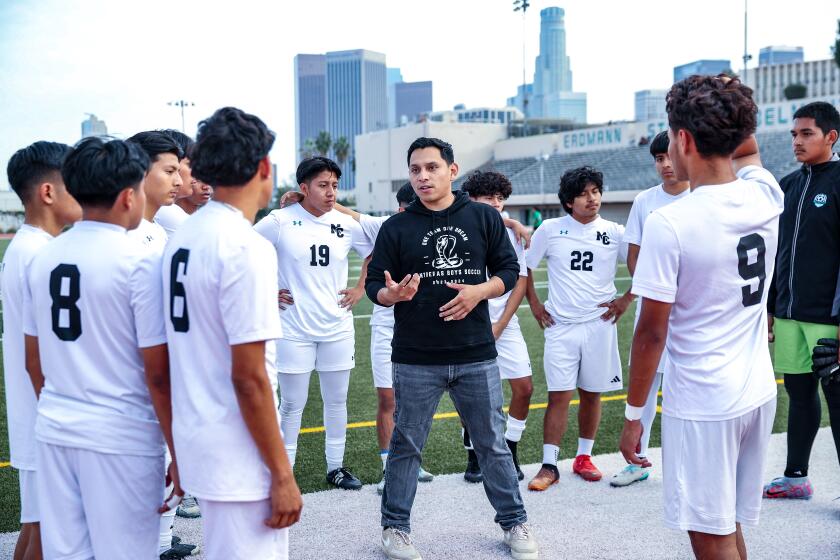The subtleties and nuances of the game elude the grasp of these wide-eyed innocents, but Little League, the cradle of baseball, plays an important part in their development. : Baby Boomers
- Share via
With the ball firmly in hand, he planted his left foot, cocked his arm and spotted his target. Just as he was about to pull the trigger, he was blind-sided, pounded to the ground by an aggressive tackler.
The sack. One of football’s most exciting defensive plays. But what made this particular sack unique was that it came during a baseball game in Woodland Hills. The victim was the second baseman. The tackler was the shortstop. The second baseman began to cry. The shortstop was confused.
“What did you do that for?” his incredulous coach asked.
“I watch TV. I know you’re supposed to sack the guy with the ball,” came the response from the 5-year-old.
Ah, Little League. A time for a boy to bring some coordination to his fast-growing muscles. A time for him to learn the valuable lessons of discipline and teamwork. A time to embark on the long road of athletics that might carry him well into adulthood.
A time for him to sack his own second baseman.
A few weeks ago, a 5-year-old playing in the Peanut Division of the Conejo Valley Little League swatted a ball through the infield. As he reached first base, the coach there waved him on to second base. Then the third base coach waved him into third. And as the outfielder continued to juggle the ball, the coach waved his arm and barked, “Go home, go home, go home.”
The boy stopped. A pained look crossed his face. And he walked off the field, into the parking lot and stood beside his father’s car, clearly upset that during this, his proudest moment, his coach was ordering him to go home. There, he imagined, he also would be sent to his room without supper. Baseball, the boy quickly concluded, was a tough game to figure out.
When his coaches explained to him what “home” was in baseball, the boy felt much better. Now, he could return to the field and go home. Wrong. Now he was out.
For adults who have followed baseball for decades, it’s a simple game. The years have pounded the rules indelibly into the mind. But for 5-year-olds, people whose cognizance is measured not in years but, perhaps, months, baseball can be as difficult to understand as Pee-Wee Herman’s popularity.
Pretend for a moment that you know nothing about baseball. Pretend you are a San Diego Padre.
If the pitcher throws the ball four times and the balls arrive at home plate outside a certain area, you get to walk down to first base and stay in the game. If the pitcher throws three balls inside that certain area, you have to go back to the bench and sit down and you can’t play for a little while. If you swing and miss, that counts the same as one of those pitches that was in that certain area. And if you swing and hit the ball, but it goes outside those long white lines, that also counts the same as a pitch in that certain area.
Got it?
OK. Now, you hit the ball inside the white lines. If someone catches it before it hits the dirt, you’re out and you go sit down. If it hits the dirt before someone catches it, you’re safe and you stand on first base. Unless, of course, someone picked the ball out of the dirt and threw it to first base and it got there before you did and the guy at first base with the glove caught it. Then, you’re out and you go sit down.
Got that?
OK. Now, you’re in the field and wearing the big leather glove. You’re the second baseman. One of the guys from the other team has reached first base. The next batter hits the ball to you. All you have to do is step on second base, and the guy who was running from first base is out. You don’t even have to tag him. The next inning, a batter hits the ball into the outfield and the outfielder throws it back to you. And here comes the batter, running from first to second, just like the other guy did. You hold the ball and step on the base, just like you did last inning. But this time the runner is safe. This time you did have to tag him.
Now, wasn’t that pretty simple?
Forget it. A 5-year-old--the youngest age for which organized leagues are available--has as much chance of figuring out what really took place in the Iran- contra arms deal as he has of understanding which base to throw the ball to or when to run and when not to run.
“Early in the year, there’s a lot of confusion running the bases,” said Ed Streeter, a veteran Woodland Hills Little League coach. “Often, there’s a reluctance to believe the coach. We’ll tell a kid to run, and he won’t. So you end up with one kid standing there trying to make up his mind and another kid behind him who keeps on running.
“Sometimes, the kids tend to stack up on the bases like planes at LAX.”
And sometimes, like airplanes, they experience a little turbulence. Mike Sheehan, who coaches youngsters in Thousand Oaks, recalls the time one of his infielders came to him before a game, showed him a very loose baby tooth that was about to fall out and vowed to let a ball hit him in the mouth to dislodge the molar.
“I thought he was kidding,” Sheehan said.
But in the first inning, a ground ball was hit to the infielder and he responded by crouching really low. The ball hit him. Right in the nose.
“I rush out and he’s crying and I asked him if his nose hurt,” Sheehan said. “The kid says no, his nose is fine. He’s crying because the ball missed his mouth and the tooth is still hanging in there, refusing to come out.”
What’s a coach to do in that situation? “Bad luck, Johnny. Maybe the next one will really slam into your mouth. Just stay low and keep your glove out of the way.”
Sometimes, the problem facing coaches is keeping the youngsters interested in the game. You’ve heard of rain delays? Well, Greg Weber, who coaches 5-year-olds in Thousand Oaks, recalled a game earlier this year that was halted for half an hour because of a loud noise.
“We were at bat and right in the middle of the game there was a car accident on the street near the field,” he said. “The team on the field headed for the fence to watch, and then my team was running right behind them. Then both benches emptied. Everyone’s hanging on the fence trying to see the cars.
“We almost got them settled down and back onto the field, and then here come the fire trucks and an ambulance, sirens and all. That was pretty much the end of that idea for a while.”
At other times a lad is in the game, but not really in the game.
“I had a kid playing infield, and all he was interested in was seeing how much dirt he could pack into his glove,” said Brian LaBeau of Thousand Oaks. “He was just sitting down, scraping up dirt and jamming it into his glove. Kids are hitting the ball and running around him on the bases, and he just ignored them. He had no interest at all in the game. I told him he should stand up and start playing, and it looked for a minute like he might. But then he just started scraping up more dirt and packing it into his glove.”
Streeter, the Woodland Hills coach, said that a coach cannot oversimplify any explanation of the game to a 5-year-old. And often, without knowing it, a coach is giving conflicting messages. For instance, given a child’s penchant for losing things, when coaches hand out uniforms they patiently explain to their players that they must keep track of them at all times. If you leave the uniform somewhere, go back and get it.
This is sound advice, of course. Unless a coach fails to mention that there are good times to retrieve parts of your uniform and there are bad times to do it. While running the bases, for example, is a bad time.
“It’s fairly common for a kid’s hat to fall off when he’s running,” Streeter said, “and often the kid will stop right there, walk back and pick it up. He doesn’t care if he’s halfway to second base. If he drops that hat, he figures he has to get it. It’s a matter of priorities. At that stage, keeping your hat on has a higher priority than getting to second base.
“You can get frustrated and yell at them, but they don’t listen. You just take them aside when you can and tell them the next time their hat comes off when they’re running the bases, just to keep running. I tell them I’ll be in charge of hats. If it falls off, I’ll go and get it for them.”
But despite all the zaniness of Little League, most coaches wouldn’t trade any one of their players for Pedro Guerrero.
“Coaches at this level do it first because of their love for the game, and secondly because it’s likely one of their own kids is out there and they want to be closer to their children,” said Dan Fredriksen, director of the Peanut Division in the Conejo Valley Little League. “Our coaches do it because it’s a chance to watch these kids grow and mature and become more outgoing. It’s almost like the coaches are creating something when they help a child develop. It’s a good feeling.
“There are times when these coaches just want to pull their hair out, but in the overall picture, the pratfalls and problems they run into are just a grain of sand on the beach. The overall experience is just great.”
More to Read
Get our high school sports newsletter
Prep Rally is devoted to the SoCal high school sports experience, bringing you scores, stories and a behind-the-scenes look at what makes prep sports so popular.
You may occasionally receive promotional content from the Los Angeles Times.






